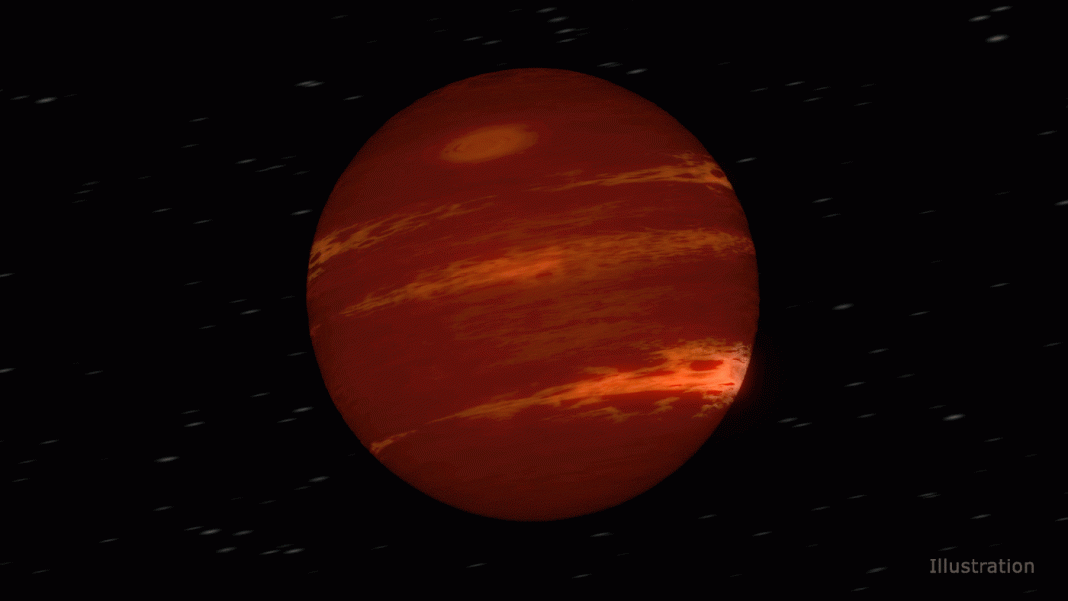Brown dwarfs are smaller than the Sun but larger than Jupiter and are relatively dim in comparison to many other objects in the night sky. Their climate tends to be windy with many hot patches of clouds consisting of silicate dust and iron droplets. These giant clouds are able to change their size by becoming thicker or thinner and can move very quickly. But why is that?
New research carried out seeks to explain how clouds change shape and move quickly on brown dwarfs. Using insights from NASA’s Spitzer Space Telescope researchers have designed a model that shows giant waves causing extreme movement of particles in the brown dwarf’s atmosphere as well as the changing thickness of the silicate clouds. Researchers are also confident that the clouds are separated into different bands depending on their latitudes, and traveling at different speeds.
The way in which the clouds move and how they are distributed on brown dwarfs is very similar to those that can be seen on Jupiter, Saturn, Uranus, and Neptune. Observations of Neptune from NASA’s Kepler spacecraft showed how the planet’s cloud structures also followed banded paths, although it’s clouded consist of ice. “The atmospheric winds of brown dwarfs seem to be more like Jupiter’s familiar regular pattern of belts and zones than the chaotic atmosphere boiling seen on the Sun and many other stars,” said the study’s co-author Mark Marley of NASA’s Ames Research Center in California’s Silicon Valley.
Brown dwarfs are often dubbed as “super planets” because of the sheer size of them. They’re made up mostly of hydrogen and helium and are known to have atmospheric storms quite regularly. Brown dwarfs are often found away from any planetary system, and because they have no bright stars obscuring them, they are much easier to study than planets. Lead author of the study and associate professor of astronomy and planetary sciences at the University of Arizona, Daniel Apai, said, “It is likely the banded structure and large atmospheric waves we found in brown dwarfs will also be common in giant exoplanets.”
As part of the study, the researchers monitored the change in the brightness of six brown dwarfs over a period of more than a year. During this time, they witness each of the brown dwarfs rotating 32 times. As they did, clouds would move in and out of the brown dwarf’s atmosphere, altering its brightness each time. Analyzing these variations in brightness gave scientists an insight into how silicate clouds are distributed among them. In order to make sense of the data received about the fluctuating brightness of the brown dwarfs, scientists created a model to demonstrate the variations in waves that affected how the cloud structures would rotate at different speeds for those different bands.
Theodora Karalidi is a University of Arizona researcher who took to using a supercomputer and new algorithm to create maps showing the pattern of how these clouds move on brown dwarfs. “When the peaks of the two waves are offset, over the course of the day there are two points of maximum brightness,” explains Karalidi. “When the waves are in sync, you get one large peak, making the brown dwarf twice as bright as with a single wave.” Next, the researchers would like to study what causes the waves that make that behavior.
More News to Read
- Want to Learn PHP? Here are Tips and Sources to Start
- VIral and Human DNA combine to make Vaccines more Potent
- Are Twinkling Little Enzyme’s the Answer to Curing Cancer?
- New Experimental Drug Kills Cancer Cells When Combined With Chemotherapy
- Scientists Discover New Hair Growth Technique Using Stem Cells










